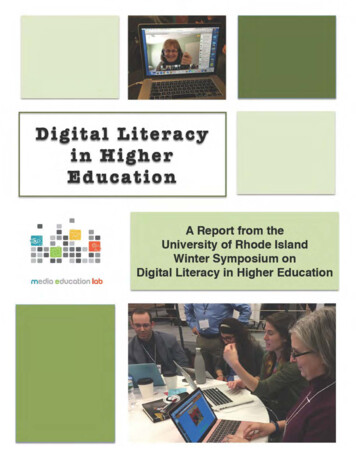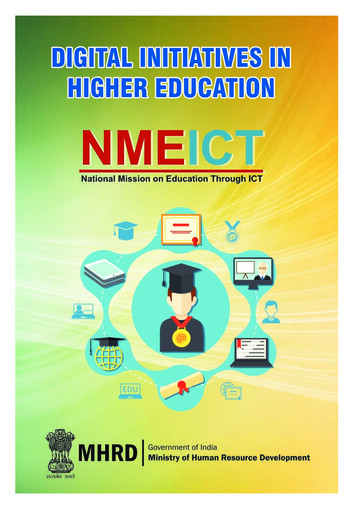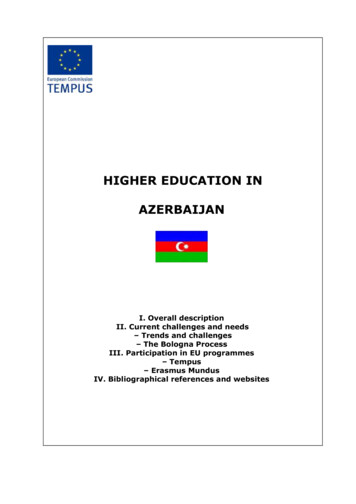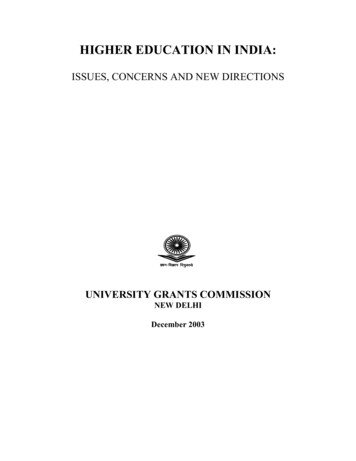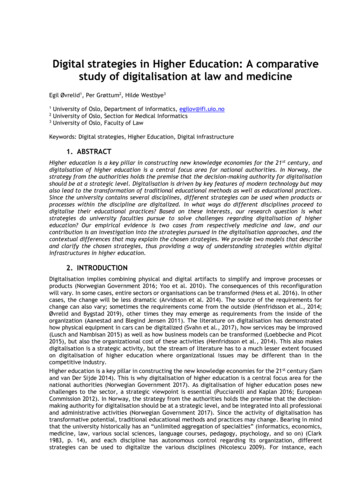
Transcription
Digital strategies in Higher Education: A comparativestudy of digitalisation at law and medicineEgil Øvrelid1, Per Grøttum2, Hilde Westbye31University of Oslo, Department of informatics, egilov@ifi.uio.noUniversity of Oslo, Section for Medical Informatics3University of Oslo, Faculty of Law2Keywords: Digital strategies, Higher Education, Digital infrastructure1. ABSTRACTHigher education is a key pillar in constructing new knowledge economies for the 21 st century, anddigitalsation of higher education is a central focus area for national authorities. In Norway, thestrategy from the authorities holds the premise that the decision-making authority for digitalisationshould be at a strategic level. Digitalisation is driven by key features of modern technology but mayalso lead to the transformation of traditional educational methods as well as educational practices.Since the university contains several disciplines, different strategies can be used when products orprocesses within the discipline are digitalized. In what ways do different disciplines proceed todigitalise their educational practices? Based on these interests, our research question is whatstrategies do university faculties pursue to solve challenges regarding digitalisation of highereducation? Our empirical evidence is two cases from respectively medicine and law, and ourcontribution is an investigation into the strategies pursued in the digitalisation approaches, and thecontextual differences that may explain the chosen strategies. We provide two models that describeand clarify the chosen strategies, thus providing a way of understanding strategies within digitalinfrastructures in higher education.2. INTRODUCTIONDigitalisation implies combining physical and digital artifacts to simplify and improve processes orproducts (Norwegian Government 2016; Yoo et al. 2010). The consequences of this reconfigurationwill vary. In some cases, entire sectors or organisations can be transformed (Hess et al. 2016). In othercases, the change will be less dramatic (Arvidsson et al. 2014). The source of the requirements forchange can also vary; sometimes the requirements come from the outside (Henfridsson et al., 2014;Øvrelid and Bygstad 2019), other times they may emerge as requirements from the inside of theorganization (Aanestad and Blegind Jensen 2011). The literature on digitalisation has demonstratedhow physical equipment in cars can be digitalized (Svahn et al., 2017), how services may be improved(Lusch and Nambisan 2015) as well as how business models can be transformed (Loebbecke and Picot2015), but also the organizational cost of these activities (Henfridsson et al., 2014). This also makesdigitalisation is a strategic activity, but the stream of literature has to a much lesser extent focusedon digitalisation of higher education where organizational issues may be different than in thecompetitive industry.Higher education is a key pillar in constructing the new knowledge economies for the 21 st century (Samand van Der Sijde 2014). This is why digitalisation of higher education is a central focus area for thenational authorities (Norwegian Government 2017). As digitalisation of higher education poses newchallenges to the sector, a strategic viewpoint is essential (Pucciarelli and Kaplan 2016; EuropeanCommission 2012). In Norway, the strategy from the authorities holds the premise that the decisionmaking authority for digitalisation should be at a strategic level, and be integrated into all professionaland administrative activities (Norwegian Government 2017). Since the activity of digitalisation hastransformative potential, traditional educational methods and practices may change. Bearing in mindthat the university historically has an “unlimited aggregation of specialties” (informatics, economics,medicine, law, various social sciences, language courses, pedagogy, psychology, and so on) (Clark1983, p. 14), and each discipline has autonomous control regarding its organization, differentstrategies can be used to digitalize the various disciplines (Nicolescu 2009). For instance, each
particular discipline may prioritise maintaining educational standards, and the high-level strategiesfrom the authorities may, thus, experience counter-strategies (Pucciarelli and Kaplan 2016). A betterunderstanding of the chosen strategies is needed to understand how national digitalisation initiativesare balanced towards the independent assessments and decisions of each discipline. Since strategicapproaches to digitalisation may differ in each discipline we ask, what strategies do universityfaculties pursue to solve challenges regarding digitalisation of higher education?We investigated two classical disciplines, law, and medicine, at the biggest university in Norway. Bothhave a historical tradition of the entrepreneurial mindset seen as an important fundament fordigitalisation of higher education (Pucciarelli and Kaplan 2016). To develop our argument, we framethe research within digital infrastructures theory (Henfridsson and Bygstad 2013, Hanseth and Lyytinen2010), both to identify contextual challenges that conditions and forms the strategic approach, andto identify how these challenges changes or transform the digital infrastructure. Our main contributionis two models that contribute to understanding, explaining, and managing strategic challenges.3. RELATED RESEARCH3.1. Digital infrastructuresA fundamental understanding of information systems requires taking into account both the technology,the organization, and the individual agency, and their collective action in dealing with the variousrequirements (Orlikowski and Iacono 2001). In addition, the increasingly networked information andcommunication channels of modern organisations make it advantageous to see information systems asdigital infrastructures (Henfridsson and Bygstad 2013; Hanseth and Lyytinen 2010), where systems,organisations, and agency are interconnected in a way that makes it important to see their contextualcontingencies.A central interest within infrastructure literature has been to understand the patterns and mechanismsby which infrastructures evolve (Henfridsson and Bygstad 2013). While some instances of the literatureframe the evolution as a managed alignment between IT capabilities and the business processes(Broadbent and Weill 1997; Broadbent et al., 1999), others are rather occupied with the radicalemergence of evolutionary paths through serendipitous innovation outside management control(Ciborra et al., 2000). Work inspired by this last tradition often focuses on evolution as something thatis formed inside the organization in the different practice environments that operate there and therole they have in shaping the evolution (Aanestad et al., 2017; Aanestad and Blegind Jensen 2011). Athird and relatively recent stream of research within this literature is occupied with how strategicplanning and the digital infrastructure is aligned to enable innovation, adoption and scaling(Henfridsson and Bygstad 2013; Henfridsson et al., 2014).3.2. Addressing strategic challenges in digital infrastructure evolutionThe digital infrastructure literature highlight three key strategic challenges in IS implementation: todefine a competitive strategy and achieve alignment between strategy and IT capabilities; to align thestrategy with the related practices to obtain actual alignment; and to ensure that strategy is asustained activity (Arvidsson et al., 2014). This has several implications for digital infrastructurestrategy.First, there must be a clear strategy that takes into account the opportunities afforded by the ITportfolio. The “planning literature” within IS (Ansoff 1980; Henderson and Venkantraman 1993) isoccupied with how management identifies new trends and tendencies. Recently a similar businessoriented stream of literature has claimed that strategies must be planned, initiated, managed, andmaintained by some form of central leadership (Hess et al., 2016; Sia et al., 2016). The managementwill also have to take into account the digital resources, which are the existing IT components,architectures, and products (Nambisan 2018) when defining and implementing strategic plans.Secondly, an organization is adapted to different purposes and is in possession of different propertiesto solve these purposes. This implies that strategy must take into account the internal organization ofthe existing firm and the various knowledge workers’ epistemic practices (Nerland and Jensen 2011).Moreover, in fields where specialized professional knowledge dominates, the decentralized autonomyis notable, transparency may be low, and degree of uncertainty high (Mintzberg 1983). If the internal
knowledge workers or activity systems (Jarzabowski 2003) have a rather autonomous culture, thestrategies chosen should be aligned accordingly (Henfridsson and Lind 2014).This means that the strategy must take the knowledge workers and activity systems into account inthe digitalisation activity, but since the practices have a different impact on digital strategy, thedegree of inclusion and participation in the change process will vary (Hautz et al., 2016). However, itis a management challenge to ensure that different stakeholders contribute to the change process bymoving “forward using their differences, in a productive rather than in a fractious way” (Quick andFeldman 2011, p. 283).Third, the strategy must be a sustained activity, where the governance of the infrastructure at theadministrative level, secures continuity, and controls interruptions (Cerullo and Cerullo 2004).Management has a particular responsibility since emergent requirements like new educationalstandards or new research areas, needs to be taken care of continually (Wiltbank et al., 2004).Our goal in this paper is to understand strategies in digitalisation of digital infrastructures in highereducation, and the contextual challenges that form the strategy. To gain knowledge of how ISstrategies are formed to solve particular challenges in higher education, we investigated two classicaldisciplines law and medicine. We will describe our findings after the method chapter, which is next.4. METHODTo shed light on the strategies by which digitalisation projects in higher education are performed, weinvestigated two cases. We chose a longitudinal process study (Langley 1999) to study the phenomenaover time and to investigate the longitudinal interaction between organisations, humans, andtechnology. Our case study research approach is based on engaged scholarship (Mathiassen 2017)where informants are not only sources of empirical data, but also helpful in constructing narrativesand discuss theoretical and practical implications.Table 1: The casesAimCaseTriggerE-learninginmedicineTeachers want to improve students’mastery of communication, practicalprocedures, visual analysis, and clinicaldecision-making. Students want moredigital feedback.To facilitate a betterand faster learningprocess to educatebetter doctorsResultThe number ofusers is notknownDigitalsources oflawThe market requires more digitalcompetency amongst the students of lawTo educate law studentswith more digitalcompetency4500 users bythe end of 20194.1. Data collectionThe data collection was done between January and June 2019. 13 interviews are conducted in additionto document and web-page analyses. A range of documents and digital resources like web pages, shortfilms, and slides were analyzed. Finally, several discussions regarding findings and possibleinterpretations were performed in seminars and workshops, Moreover, two of the authors were centralin identifying and analysing material as a part of their regular work tasks. The first author is workingas a researcher and is responsible for interpreting and analysing the data.4.2. Data analysisIn the analysis, we first established a chronology of important events. Building on Langley’s (1999)approach on process data, we analysed the historical background for the projects and were especiallyinterested in the technology initiatives and how they were related to specific key events.The analysis revealed three central activities. First, we inspected the planning activity and identifiedthe existing digital resources. Then, we focused on the various activities performed to align the plan
with the professional workers and the students. Lastly, we were able to see how the strategy took intoconsideration systematic follow-up and maintenance of the digital infrastructure.We see both cases as performed within digital infrastructures since a huge amount of students,teachers, administrators, and developers, as well as resources, routines, processes, and activities froma range of stakeholders, are involved. In the case of law, more than 4500 students use the systemregularly, while in medicine over 1000 students are using the e-learning infrastructure.Table 2: Data analysisStepDescriptionOutput1Identify key events, key objects in the history of the facultyTimeline for each project2Analyze cases: planning and digital resources, alignstrategy and professional workers, follow up and maintainSection 53Propose two models two describe the core content ofstrategiesSection 65. FINDINGS AND ANALYSISThe two investigated cases have a rich and interesting history with continual use of technology tosolve core challenges within the respective areas. Since the two disciplines’ inner workings make asignificant impact on the strategy, the various strategies may deviate from the ones espoused by theministries. In 5.1 and 5.2, we will describe digitalisation initiatives at respectively medicine and law.5.1Digital education in medicineDigitalisation of the education at the Faculty of medicine spans a wide range of activities – fromdeveloping and implementing a student information system to digital exams, support systems forlecturing and group work, and a large portfolio of e-learning programs mainly for self-study. Thisanalysis will focus on e-learning programs.Figure 1: History of e-learning in the faculty of medicineThe e-learning activity started in 1992 when two teachers developed a series of text and image basedprograms to teach students basic medical procedures like taking a blood sample. In 2000, the Dean ofstudies funded and launched a new initiative to employ IT in education, focusing on establishing andstudying net-based collaboration during clinical placement. A year later e-learning was included as atarget area. The professor of medical informatics was put in charge of IT in education. This is now afull-time activity. Two technical positions were funded as well as an annual project call targeted atthe teachers. In 2010, the section of medical informatics was established directly under the Dean toemphasize the over-arching responsibility of the team. E-learning programs are openly published in anational infrastructure loosely shared by the Norwegian medical faculties. Today the digital resourcescomprise approximately 50 smaller or larger programs that include several hundred videos and linksto server-based functionalities like formative tests and virtual microscopy. 1 The development of newprograms can best be described as an educated development in collaboration with educationalscientists and the faculty’s newly appointed psychometrician.1The digital infrastructure (http://meddev.uio.no/elaringsportalen/) is currently housing an extendedamount of resources from 52 disciplines.
Strategic planning of e-learningThe ultimate goal of the e-learning and teaching as a whole is to produce highly qualified doctors.Many if not most teachers are constantly looking for ways to improve the learning process and thelearning outcome. Medicine is a “handicraft” full of human interaction and sensory input – visual,auditive, tactile – and complex and intertwined life processes. Learning this through books can bequite hard, whereas IT through its ability to handle multimedia, dynamics, information networks, andinteractivity facilitates this type of learning. Students are constantly complaining about the lack offeedback on their learning progress. This is partly due to limited resources, and automated formativetests with extended feedback on the answers are seen as a partial solution to this problem. Today’sstudents are “computer savvy” from early childhood and accustomed to IT as a natural part of theirlearning toolbox. An educational institution that does not employ these tools is seen as thwarting.Finally, studying is becoming a more and more distributed and asynchronous activity, enforced by e.g.the advent of “flipped classrooms”. IT is a superior tool for delivering material distributed in spaceand time. Students are expecting digital resources that facilitate individual self-studies, but whichalso gives a stronger interaction. Examples are tests, quizzes, etc. but also other forms of resourcesthat activate the learning ability of the student.The section for medical informatics is appointed by the faculty to take care of these issues and doesthis partly by funding and participating in teacher-initiated projects to develop e-learning programs.Approximately USD 150000 is annually allotted to these projects.“The initiative does not come from the departments, but from the ground floor: the teachers.We try to involve students in all projects - their view is important because the product is forthem, but students are usually far more than "viewers" - they often produce most of theresources under the guidance of teachers.”Even though the e-learning initiative is very popular, the resources are limited, and the making of elearning is demanding for each discipline. Each discipline must, together with the three employees inthe section for medical informatics, do all the project work in addition to their regular work. Thefunding is therefore used almost entirely as part-time employment by students or freelance resources.The strategy is based on “cultivation” as it depends on independent activity from each subject area.This is challenging in that good initiatives rely on the discipline itself and is less anchored in facultymanagement.Digital resourcesThe medical education consists of eight learning modules, and there are about 50 different e-learningprograms of varying sizes and sophistication available, covering parts of all modules. The strategy fromthe faculty of medicine is twofold. First, it is to digitalize where IT has special advantages. This appliesto images, such as X-rays, eye diseases and skin diseases, and sound, for example, auscultationtraining. Furthermore, movies are used for case histories, e.g. in psychiatry and clinicalcommunication, and procedure visualization. Animation can be used to visualize process dynamicssuch as physiology and disease processes, and simulation helps to understand the processes andconsequences of interventions. Thus, both practical and cognitive skills are developed. Furthermore,technology is used to “link together material in learning hierarchies so that one can go seamlesslyfrom overview learning to in-depth learning.” [informant]Through e-learning fragmented disciplines can get virtual homes that bind the fragments together inan integrated presentation. E-learning can also be a tool for “faculty development” where e.g.teaching consistency is developed from a common knowledge base of procedures. E-learning is alsoused for student activated teaching through the use of virtual patients and interactive quizzes. Thesemany facets make e-learning an integrated knowledge system. In 2018, approximately 77000 quizzesand virtual patient cases were delivered. In addition, approximately 170000 slides were madeavailable.
Figure 2: Ultrasound: Example ofdigitalized educationFigure 2 is an example thatdemonstrates how to place the probeand to inspect the resultingultrasoundpictures.E-learningprograms like those demonstrated infigure 2 are developed and testedthrough trial and error. The sectionfor medical informatics is trying tobuild educational tools based onwhat is useful from an educationalperspective to make teachingrelevant. It must be closely matchedto the learning methods that exist.The alignment between strategy and knowledge workersAs mentioned above, the individual teachers from each discipline are the starting point for the use ofe-learning. Since the digitalisation of education relies heavily on these disciplines, the activity ofaligning the internal core of the organization with the strategy is very important:“The question of management's ability/opportunity for "strategic management" is notspecifically related to digitalisation. I think Henry Mintzberg’s description of universities ascomparable to "pigeonholes" of diverse autonomous groupings, is relevant. This characterizeseverything we do. Teaching has traditionally been "owned" by the individual teacher. Perhapscentral units, in the faculties may wish for something else, but still with respect for theindividual teacher's hegemony.”An example is given in this short vignette:“In a project on implementing the BIO model 2 we spent over a year creating a commonacademic understanding of clinical communication - a job that the project explicitly took onbecause it was not done anywhere else. This was also the case in the first edition of themovement apparatus3 where the project created consensus between four subjects on howjoints should be examined - a consensus that was not there before, but which should havebeen there. Thus, these projects can be catalysts for processes that should have beencompleted already”This tight connection between discipline and changes in the discipline makes it very challenging forthe managing unit to implement changes very fast.Strategic follow-up and maintenanceIt is very difficult to obtain specific figures on how many people use e-learning within the faculty ofmedicine. The section for medical informatics does not have these numbers, and it is also very difficultto get specific usage figures on the solution from USIT (the central IT unit at the University of Oslo).There are about 1000 medical students at the University of Oslo at any time, and they use e-learningto varying degrees. Usage varies very much and peaks during teaching and before exams. Teacherswho have carried out an e-learning project are more likely to start a new project than novices are,and there are many disciplines with no e-learning activities at all. An explanation for this could be theamount of work required by each medical area to develop an e-learning solution. First, there is a needto acquire the needed resources (money and personnel). Then they have to prioritize and focus. Thisis challenging given all the other tasks medical personnel is expected to do.2The BIO model is a way of describing the process of learning through gaining contact with the patient(beginning), gather information and summarize/plan (oppsummering in Norwegian) further treatment3This is a particular project within faculty of medicine where e-learning resources for learning aboutmovement apparatus (bevegelsesapparatet) were created.
“We had a meeting a month ago, and everybody is interested in e-learning, but there are notmany who use it systematically. There is a lot of work to do to establish a solution. We had toapply for money, and then Hannah [student] got money to do it and now we have to applyfor more money for a new project we are planning.”The development is based on communication within the network:“The network is used to identify potential stakeholders. It is primarily driven by enthusiasm.However, there is always scarcity of resources, and it is difficult to identify the amount ofuse. Resources for e-learning can remain unaudited, there are few resources spent on followup. We should have had a more continuous follow-up. There will always be a cost/benefitmeasurement between new projects and maintenance. An example of the vulnerability is thatwe had an ophthalmologist who was unstoppable in creating e-learning, but when she quit, allthe modules and systems fell away for many years until a new enthusiast appeared. Thus,there is a major problem related to management and follow-up.”As we can see, the planning and maintenance rely on the internal organization. This can be understoodin the light of the complex content of medicine (images, sound and video, and 3D), and the importanceof high inclusion. This type of “emergent strategy” has however also some disadvantages. The facultyhas limited insight into the amount of use, and how much effort is done to digitalize areas of eachdiscipline. The digital infrastructure currently consists of material from 52 disciplines, but only someof the web pages are maintained regularly. The coupling between strategy and implementation is notstrong enough. In addition, the initiative has some challenges related to knowledge building amongstthe faculty management since a very limited amount of the personnel is familiar with the technologyused. Some teachers are hoping for improvements, saying that “In practice, it will improve in a coupleof years . we will establish learning goals for each module . I think this is going to be the way onechooses to acquire knowledge .”There are, however, some shortcomings in the lack of continuity and follow-up, as well as the limitedamount of competency on the core technology. The reliance on enthusiasts or knowledge brokers(Meyer 2010) makes the strategy vulnerable.5.2 Digitalisation of sources of lawThe history of Lovdata, which is a digital infrastructure where sources of law can be looked up andinterlinked through a reference system, can be led back to the innovative activity of Jon Bing and KnutSelmer in 1970. They started an initiative called “law and data”, which in 1971 was organized in aseparate IT department. Lovdata, a self-financing private foundation owned by the Ministry of Justiceand Faculty of Law at the University of Oslo, was established in 1981. Using Lovdata, Norway was thefirst country in Europe to make electronic announcements of law regulations. Students and employeesat the faculty of law have used Lovdata in education since the late 1990s, but the classic papercollection of Norwegian acts was in 2017 still the most central object for the faculty.Figure 3: From emergent to planned strategy at the faculty of lawStrategic planning: why digitalise sources of lawThe business world of lawyers requires a high level of digital expertise. For a professional lawyer legalsources are the central tool, and “you are not an ordinary lawyer until you use what is in Database”[informant]. A central “ideal” for the faculty of law, thus, is the “regular lawyer who works in thebusiness world.” Students have been using Lovdata in education for some time, but until recently toa very limited degree. One of the challenges for the faculty of Law was that students could get
excellent grades, even if they never entered Lovdata. The reason for this was that even though Lovdatawas used in education, the exam was still performed using books, pen, and paper. Since the studentsare strongly motivated by the grade and therefore the exam, the faculty of law decided to change thestrategy. In 2017 the faculty of law announced a tender, and Lovdata – which had 30 employees andover 200 information bases – needed to make changes to deal with new requirements. Specifically,Lovdata implemented a sophisticated reference system allowing annotations and personal notesconcerning the laws. Moreover, Lovdata became mandatory on the exam. Earlier the students“memorized” the textbook, made notes in the law book, and used the collection of legal judgmentsthat were relevant to the subject. Now they needed to use Lovdata also in education.Digital resourcesThe primary source of law is legal text. But, the law must be interpreted, there are ambiguities, weget a hierarchy of sources of law with preparatory work (investigations and propositions), case law(supreme court, 4 courts of law, district courts), and legislative text (case law, administrativepractice, complaints). Figure 4 is an example from “Forbrukerkjøpsloven” 4 and the various references(in yellow, red, and blue) are sources that can strengthen the law practice regarding this particularparagraph in the law. The use of colors and drawings is comparable to previous paper aids butcontributes by referring to related sources of law via links. This makes the use of the system dynamicand practical. The system also checks what comments and references that may be accessed on thedigital exam.Figure 4: Digital sources of law in a reference system“The students individualize the material through the semester, through notes, cross-teaching,and so forth. The reward is that Lovdata can be used on the exam. The practice changes thesubject. Earlier the students used learning tools no one controlled, there was no clear learningstrategy, and the preparation work (done through the semester) was not awarded. Now thepractice of law is done more correctly, with less focus on memorizing and more reward givento use of juridical method through the semester. The work done through the semester isrewarded. A lot of work needs to be done in advance; they cannot do everything on the exam.”According to the Dean of education, “there is a difference between those who have been on thesurface and those who seek the depth. Lovdata changes the practice.”Alignment between strategy and knowledge workersLovdata implemented the system in 2017. The faculty did not have many resources, however, a projectgroup was set up to plan the introduction together with the Dean of education. The administrativemanager at the library was central in the planning of the project's training of teachers and students.The plan was to implement the system fast, but only a limited number of students were chosen to useit the first year. The course “Juss1111” was chosen as a pilot. Then the solution was rolled o
Digital strategies in Higher Education: A comparative study of digitalisation at law and medicine Egil Øvrelid1, Per Grøttum2, Hilde Westbye3 1 University of Oslo, Department of informatics, egilov@ifi.uio.no 2 University of Oslo, Section for Medical Informatics 3 University of Oslo, Faculty of Law Keywords: Digital strategies, Higher Education, Digital infrastructure

